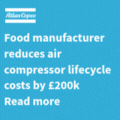
Posted to News on 20th Jun 2016, 14:08
Movicon SCADA provides visualisation and control for biodigester
The entrepreneurial spirit is strong with Henry du Val de Beaulieu who is building a giant 10,000 cubic metre fourth biodigester tank at his farm estate in Hampshire. Providing site visibility and remote control over most aspects of this already large anaerobic digestion enterprise site, including key parameters such as equipment status, temperature, pressure and gas / electricity generation is the robust and easy to use Movicon SCADA system provided by Products4Automation (P4A).
Fuelled by local crops, the site produces a small amount of electricity, some of which is used to power the three AD plants. Two CHP units provide heat for the process in addition to keeping the farmhouse and outbuildings warm in the winter months. The main output however is biogas, which is cleaned and mixed with propane to match target calorific values and then fed directly into the national gas main system.
Systems Engineer Steve Brand comments: "I have used several mainstream HMI / SCADA solutions in the past and frankly none of them is perfect; what we have found with Movicon however is that it is extremely stable, easy to program and easy to expand. The plant is growing in terms of the level of automation technology and sheer size, the latest lagoon which is being roofed at the moment is set to be one of, if not "the' largest in Europe. This means more processes need to be added to the control screens and we need to increase the data volumes we are processing and storing.
"There are some convenient built-in features with Movicon such as secure web services and good database support, which we like. I had to make some tweaks to the plant from Italy last week for example and the process worked seamlessly. I viewed live data, made a change and implemented it all online; with the confidence that back in Hampshire the changes were taking place and that I could check on the results later in the day to make sure everything was as expected.
"This a common feature now with this type of control and visualisation tool, but it is often not as easy to implement as the vendors would make out. In this case Movicon has been easy to use and I'm looking forwards to expanding the capability with a dedicated historian which will allow us to do more sophisticated trending analysis, which in turn should lead to practical changes we can make to the plant to improve efficiency and output."
In testament to the system's stability and reliability, for the fi;rst quarter of 2015, Apsley Farms was the top generator in the country in terms of up-time among those using the feed-in tariff subsidy, being 97.8 per cent available on average.
After a total investment approaching 20million Apsley Farms near Andover in Hampshire now produces sugar beet, rye and maize feedstocks on around 1000 acres, all for the onsite production of biogas. Growing feedstocks on the edge of Andover can produce high yields such as 30 tonnes an acre for Sugar beet, so this helps the economies of transportation.
Business began with a small anaerobic digester producing 500 kilowatts of electricity a year and grew until it started putting electricity into the national grid in October 2012. Today, Mr du Val also adds crops from other farms to feed the three existing anaerobic digesters.
When the fourth one is online the site will be producing enough gas to power the equivalent of 8000 homes. By then the four AD plants will be consuming the equivalent of 110,000 tonnes of maize, rye, grass, sugar beet, wheat and barley each year which, to save you the maths, is the equivalent of 12 tonnes an hour, every hour, 24/7.
Apsley Farms was the fi;rst in the UK to use an aerobic hydrolyser, which improves the quality of the feedstock and boosts the AD plants methane production to between 57 per cent to 60 per cent, which is more effi;cient than other plants. Before the gas goes into the Scotia Gas Networks pipeline, it is compressed through membrane technology which separates the CO2 from the methane, and a small amount of propane is added to the methane to take it up to the national calorific standard before it goes into the grid after being odorised.
The third AD plant is a bag in the ground instead of the more conventional concrete. A hole was dug and insulated, heating pipes were put across the bottom and the sides, a giant purpose made "bag' was dropped in the ground, a couple of paddles were put in and the contents heated and stirred gently. According to Mr du Val it makes just as much gas as a conventional AD plant and the idea has been repeated many times since - including in African villages.
Please visit www.products4automation.co.uk for more information about the Movicon SCADA system.
4th Floor, Patrick House
39 Eastern Road
B73 5PA
UNITED KINGDOM
+44 (0)845 077 3858





